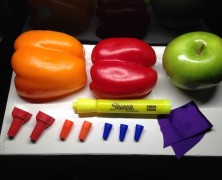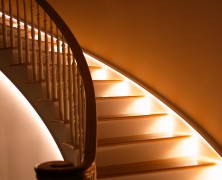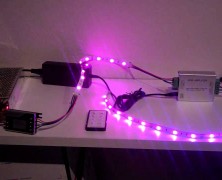CRI, or Color Rendering Index, is the latest buzzword in consumer lighting circles. With the current phasing out of traditional incandescent bulbs, many consumers are scrambling to understand their remaining choices. Savvy lighting manufacturers understand this, and have invested a great deal in educating customers about things like color temperature, lumens, and now CRI. So how does CRI work? Basically, take a light bulb and shine it onto a few bright, colorful items. How natural do their colors look? Color Rendering Index is a mathematical measure of this, where a light source is tested and given a score from 0-100. Any light bulb, tube, or strip that measures greater than 90 is typically considered “High CRI”, and thus very effective at rendering natural-looking color at a given color temperature. As a point of reference, many of the fluorescent or other types of lighting that people consider “harsh” or “artificial” measure in the 50-70 CRI range. Take a look at the two photos above. In the first photo, under lights rated at CRI 57, the orange bell pepper has lost much of its natural color, appearing almost yellow. Similarly, the green apple, red bell pepper, and yellow marker appear dull and lifeless. In the second photo, under CRI 93 lighting, the colors are much more alive in comparison, down to the white board on which everything is placed. Testing for CRI requires special machinery designed specifically for this purpose. During this test, a lamp is shone onto eight different colors (or “R values”), termed R1 through R8. The lamp receives a score from 0-100 for each color, based on how natural the color is rendered in comparison with how the color looks under a “perfect” or “reference” light source at the same color temperature...
Flexfire LEDs Announces High CRI LED Strip Lights...
posted by Flexfire LEDs
In keeping with its commitment to providing innovative LED lighting solutions, California-based Flexfire LEDs has announced its new UL Listed UltraBright™ High CRI Series LED Strip Lights. Designed to meet today’s higher lighting quality standards, this new line measures >93 on the color rendering index, fortifying the company’s reputation for delivering cutting edge technology at consumer-friendly prices. CRI, or color rendering index, is the standard measure of a luminaire’s ability to accurately render a specific color spectrum in comparison with a perfect reference source at a given color temperature (i.e. daylight). Simply put, if you direct the light onto a particular object, how natural do its colors look? Testing for CRI is a complicated process, requiring specialized machinery designed specifically for this purpose. Lamps are tested in terms of how they render eight basic colors (or “R values”), termed R1 through R8. A score from 0-100 is given for each color, and these eight numbers are then averaged to determine the lamp’s overall CRI rating. Those measuring above 90 are generally considered highly effective at rendering natural color; for a practical understanding, many of the traditional fluorescent lights that people consider “harsh” or “artificial” measure in the 60-70 CRI range. LED lighting is the established industry leader in energy efficiency, and advanced technological development means LED products are now available at dramatically lower prices than even just a few years ago. This dynamic is driving a worldwide shift to LED lighting, one that is further accelerated by government regulations such as those found in California’s Title 24. Established by the State’s Energy Commission, Title 24 addresses a number of energy efficiency standards, particularly those having to do with lighting. To be classified as “High Efficacy” and thus qualify for utility rebates and other advantages,...
LED Staircase Lighting...
posted by Flexfire LEDs
One of our customers created dramatic LED staircase lighting in his home using Warm White ColorBright™ strip lights from Flexfire LEDs. The strips were inserted into a routed channel along the staircase, and attached to a Honeywell programmable timer switch to enable automatic on/off at specific hours of the day. This installation adds aesthetic flair to staircases in both homes and commercial spaces, carrying increased safety benefits as well, particularly for the elderly and small children. In fact, according to a 2012 study published in Pediatrics magazine, a child under the age of 5 is admitted to U.S. emergency rooms every six minutes as a result of staircase accidents. Smart, safe, and great looking – a winning combo for your home or office! Choose one of our convenient Flexfire LEDs strip light kits to suit the appropriate brightness, length and color of your LED display case lighting project: ...
LED Walkway Lighting
posted by Flexfire LEDs
Use bright, durable, and energy-saving LED walkway lighting to illuminate indoor staircases, garden paths, office hallways, and other dimly lit traffic areas. In your home or office, having illuminated stairs is a dramatic aesthetic improvement that will also increase safety, especially for seniors and small children. Despite its benefits, this improvement has traditionally been overlooked due to concerns about increased energy consumption and difficult installation. LED walkway lighting can be used to illuminate your staircase while avoiding these concerns – Flexfire’s UL Listed LED strip lights use 75% less energy than standard incandescent bulbs, generate virtually no heat, and are easy to install with versatile products such as UltraBright™ and ColorBright™ series LED strip lights. Further, high quality LED lights last up to 50,000 hours, meaning they’ll brighten your day for more than a decade. These benefits apply when using LEDs in other sorts of high traffic areas as well. LED walkway lighting can be used to beautifully accentuate home garden paths, office hallways and outdoor corporate plazas, with multiple color and brightness options to choose from. Wherever you go, use LEDs to light the way. Choose one of our convenient Flexfire LEDs strip light kits to suit the appropriate brightness, length and color of your LED walkway lighting project: ...
Video: LED Amplifier Installation...
posted by Flexfire LEDs
If you want to run LED strip lights in a long, continuous section, you will need to use amplifiers. Fortunately, LED amplifier installation is a simple, do-it-yourself installation that is explained in the video...










